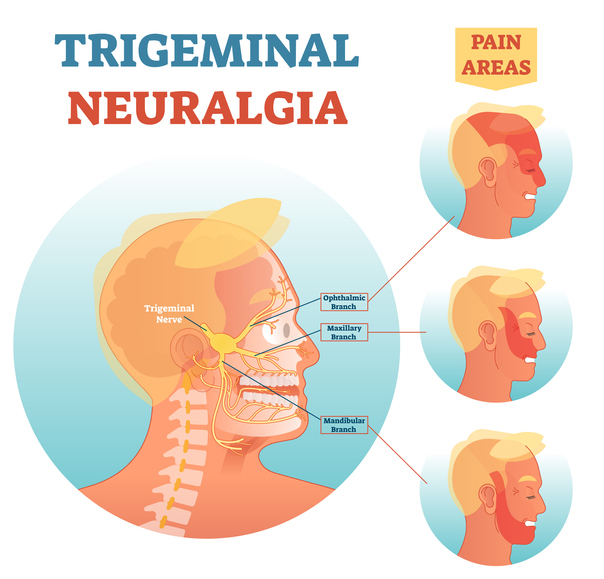
Stuffy head and pounding headache. Dull and squeezing pain in the head.
Have you frequently experienced these pains in your head? Over-the-counter drugs may no longer work effectively.
You may think that treatment or medication provided by medical specialists work more effectively against your headache and help reduce recurrence of the symptom.
If so, which medical specialist should you visit? The answer is a neurologist which is what I specialize. A neurologist is the best choice to visit in order to get reliable diagnosis and treatment for most of the headaches. There are various types of headaches, and of course, some are successfully improved with use of OTC drugs. However, majority of the people who visit neurologists suffer from headaches where OTC drugs no longer relieve their symptoms.
Some patients assume that they suffer from “migraine” when they visit the doctor. However, in reality, only 10% of those patients are actually diagnosed with migraine – among those patients, most of them have tension headache, or migraine complicated by tension headache. Besides, effective medication depends on the types of headaches patients suffer from. The most effective approach for a headache is when patients have a better understanding of their headaches and choose the right medication based on its symptom.
In this article, neurologist Dr. Yoshiya Hasegawa provides useful information on how to diagnose/ deal with the headache.
Contents
1. Why headache medicine does not work?
Headache sufferers who visit a neurologist often complain that the headache medication which they are prescribed with or get from a drug store is not effective against their symptoms. Why does the medication not work on them?
1-1. OTC drugs are mostly less effective
Compared to prescription drugs, over-the-counter (OTC) drugs tend to involve fewer active ingredients. OTC drugs are available to everyone, and some people may take 10 times more than the determined dosage of the medicine. To avoid overdosing, OTC drugs which contain less amount and effect, as well as side effect on the symptoms are approved by regulatory agencies and made available at stores.
Prescription drugs or Rx-to-OTC switch drugs (Rx-to-OTC switch refers to the transfer of proven prescription drugs (Rx) to nonprescription, OTC status) have to be used as indicated. Any determined dosage of the medicine is never allowed to be 10 times more.
1-2. Treatment depends on the types of headache.
Most headaches are associated with muscles, blood vessels, and/or nerves around the skull, and the medication which affects respective pains differs. For example, analgesics do not relieve headaches which are triggered by problems in the blood vessels or muscles.
1-3. Combination of the different types of headache may occur.
Even though doctors prescribe appropriate medication, the prescription medicine will not work properly when patients suffer from concurrent headache symptoms. In other words, patients may experience different types of headaches each day. To understand their condition and choose right medication for each symptom, doctors must have good communication skills with their patients.
2.Two major headaches which are often confused
There are two types of headaches which commonly occur. The most common headache is considered to be a migraine but only 10% of the sufferers are actually diagnosed with migraine.
2-1. Characteristics of the migraine
It is a common headache which is associated with problem in the blood vessels. It causes pain when a blood vessel in the brain expands and stimulates trigeminal nerve around the blood vessel. The pain is very severe, and OTC drugs are ineffective against the migraine. Most migraine sufferers are young females and likely to be displayed among teenagers. It is a hereditary disorder where some mothers of these young patients had also suffered from migraine before. However, you can say that the symptoms will reduce in frequency and severity as they grow up.

Trigeminal nerves
2-2. Characteristics of the tension headache
Tension headache is typically associated with a problem in the muscle. Most of them are triggered by shoulder stiffness. The symptom usually appears in the evening when you feel tired from working or studying. OTC drugs are effective to some extent, while walking and massaging have some effects too. Some people may get headaches from straining their eyes. Remember to take a vision test, too.

Eyestrain or stiff shoulder may trigger headache.
2-3. Most patients experience both headaches
These headaches are considered to be two different illnesses. However, majority of the headache sufferers experience either migraine or tension headache which varies from day to day. In some cases, a tension headache occurring first, causes migraine.
3. How to identify migraine and tension headache
There are the differences between migraine and tension headache.
| Migraine | Tension headache | |
| Duration | intermittent | persistent |
| Location | occurs in one side of the head | occurs in both side of the head, in the whole head, or in the back of the head |
| Pain | throbbing severe pain | tightness around the head, or dull pain |
| Accompanying symptoms | nausea, vomiting, sensitivity to the light, sound and smell | may accompany stiff shoulders and/or lightheadedness |
| Activities | unable to do dairy activities due to its severe pain | Able to do dairy activities |
4. Effective treatment for the migraine: Triptan
Case scenario of a typical migraine occurring in a young female who is genetically influenced: a sudden pulsating pain after scintillating scotoma, or migraine aura, which displays a spot of flickering or shimmering light in the visual field. Generally, migraine sufferers are unable to work or perform any task as the pain is very severe. OTC drugs have no efficacy on the migraine. It is essential to use Triptan for the migraine.
4-1. Action mechanism of Triptan
Triptan generally has three actions and affects both “blood vessels” and “trigeminal nerves” where the migraine pain is triggered. It acts on the blood vessel in the brain to diminish its swelling and interfere neuropeptide to be released from the trigeminal nerves. Also, it blocks stimulation which the trigeminal nerves have received being transmitted to the cerebrum so that it may relieve other migraine-associated symptoms such as nausea, vomiting, photosensitivity, or hyperacusis.
4-2. Right timing to administer the Triptan
It is important to take Triptan timely in order to achieve its best effect. The most effective way to administer the medication is when the migraine attack is still mild or “moderate.” It is too late to take the medication if the migraine is already severe.
4-3. Types and dosages of the Triptans
Currently in Japan, five brands of Triptans are available for administration: IMIGRAN, ZOMIG, RELPAX, MAXALT, and AMERGE. Also, there are various dosage forms such as orally disintegrating/rapid melt tablets, nasal drops, and injection.
4-4. Triptan is effective but expensive
Price for Triptan is approximately 900 Japanese yen for one medicine. Assuming that majority of the migraine patients are young, and with insurance coverage in Japan which costs them 300 Japanese yen, it might still be too expensive. Despite this, they pay the amount since the efficacy of Triptan is very reliable.
5. Treatment for the tension headache
Tension headache causes a dull pain that feels as if the head is being compressed and lasts for thirty minutes to seven days. It is often described as a “pressure like wearing a helmet.” It may accompany a stiff neck/shoulder, dizziness, lightheadedness, or physical fatigue. It appears regardless of the age, from children to the elderly.
5-1. Exercise and massage may work better than medicine
Improvement of blood circulation and regular physical training tends to help relieve the symptom. Moderate workout is effective against tension headache as well as taking a warm bath or massage which increases blood flow.
5-2. Efficacy of the analgesics
Analgesics do not work much on tension headaches. If analgesics are taken every time patients are bothered by the headache, it may cause medication overuse headaches.
*Medication overuse headaches: When someone experiences a severe headache, they are more likely to take analgesics as a prevention to avoid the recurrence of a severe onset, thereby possibly increasing the frequency and dosage. This makes the brain sensitive to pain, causes more frequent headaches, and finally results in reducing efficacy of the analgesics.

It may work less effectively when you continuously intake analgesics.
5-3. Caffeine
Caffeine works well on tension headaches. SG Combination Granules which doctors often prescribe contain 50 mg of anhydrous caffeine. I think caffeine reduces symptoms more effectively than most medicinal substances.
When I feel dull in my head, I sometimes refresh myself by taking SG Combination Granules. Needless to say, medication should be used temporarily since tension headache is a sign indicating that one needs a rest. It is important to find a way to relax and make it a habit in order to avoid excessive strain on the muscles.
If you do not have time to visit a clinic to obtain prescription SG Combination Granules, you can try energy drinks instead. Many energy drinks contain 50 mg of anhydrous caffeine which is an equal amount of SG Combination Granules. It is worth trying when you feel dull and fatigued.
However, you should take note of caffeine overdose. Energy drinks contain caffeine as much as: 144mg for “Monster Energy”; 120 mg for “Rockstar”; 80 mg for “Red Bull.” Taking 50 mg of caffeine is sufficient for relieving tension headache.
Caffeine overdose has harmful side effects such as dizziness caused by central nervous system stimulant, increased heart rate, excitation, anxiety, tremor, insomnia, diarrhea, and nausea. Fatal case is also reported. Of course, it is not a problem to take 50 mg of caffeine for one day – it should not bother your health.
6. When complication occurs
There are some commonly administered medical treatments as mentioned earlier. In fact, however, migraine and tension headache are not clearly identifiable. If fatigue triggers a migraine, it may be difficult even for a specialist to find out which treatment should be administered.
In such cases, conducting a diagnostic therapy may be one of the treatment options. The patient may choose to take either Triptan or SG Combination Granules when the headache attacks. If Triptans work, the symptom is caused by migraine; while SG Combination Granules should be diagnosed with tension headache. If the sufferer finds that one of them does not work on their onset when 30 minutes to one hour has passed after their intake, they can try another medication.
Patients are gradually able to educate themselves in choosing the correct medication after experiencing several headache attacks. As a suggestion, patients can request from their doctors a preferable medication saying, “Could you prescribe more Triptan this time?” or “I only need SG Combination Granules for this onset” and so on.
The same is true of analgesics. If patients know their preferences, they can request medication as they would like to. It is important that the patients understand their right medication such as “Loxonin works better against my headache than SG Combination Granules.”
7. Summary
- Most common headaches are migraine and tension headache.
- Different treatments are administered for each symptom.
- In many cases, both headaches may occur in one patient. Diagnostic treatments which are conducted several times can eventually help patients find their right medication by themselves.

